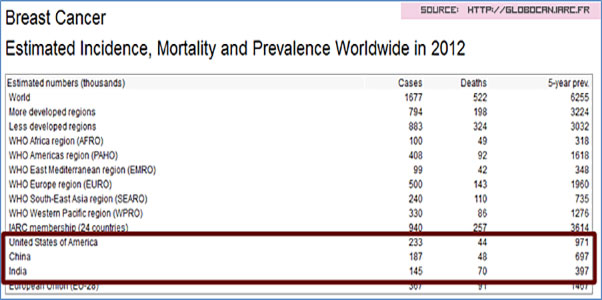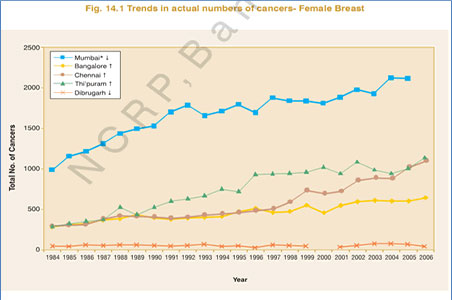Q: What is breast screening?
A: Examination of an asymptomatic and healthy lady in order to detect breast cancer at an early stage.
Q: What is the need for breast screening?

A: Breast cancer is a non-existent entity for almost a majority of the population until a known person is diagnosed. It is merely due to ignorance, lack of awareness and feeling delicate to be examined that a majority of the population present at an advance stage. Breast malignancy is the second most common malignancy in the world with an estimated 1.67 million new cases as per GLOBOCAN 2012 study. It is common both in developed and developing countries and has been found to be the fifth commonest cause for cancer death.
One, with the increasing number of cases the need for screening has become essential and two it aids in identifying the patients at risk and who do not present with any breast related symptoms.
Q: How was breast screening initiated?
A: In 1960 in USA, Oncologists found that a lady presents to a doctor only after she is symptomatic. In December 1963 the Health Insurance Plan (HIP) of Greater New York started a clinical trial with 62000 women between the age of 40 and 64 for a period of 25 years. The aim of the study was to find out if screening is better than clinical examination alone and if screening would aid in reducing the mortality rate.
Q: Why is breast screening essential in India?
A: Breast carcinoma is a global disease. Currently we see patients as young as 30 yrs of age presenting with breast cancer. An analysis of cancer rates between the years 1982 and 2005, as conducted by The Indian Council of Medical Research, showed that 10 out of every 100,000 women living in Delhi, Mumbai, Chennai, and Bangalore were diagnosed with breast cancer about 10 years ago, compared with 23 women per every 100,000 today. Breast screening is essential in India because of the following reasons:
- Age shift (More number of younger patients are affected)
- Rising numbers of cases of breast cancer in India
- Late presentation (This directly decreases long term survival of the patient)
- Lack of awareness and Screening
- Aggressive cancers in young (Generally, the younger the age below menopause, the more aggressive the cancer)


Q: What constitutes breast screening?
A: (1) Clinical examination. (2) Mammogram (which includes ultrasound correlate)
Q: Why MMG cannot be done for younger population?
A: Difficult to detect any abnormality as the breast of a young lady is radiologically dense.
Q: What are the other options available for a younger patient after ultrasound breast?
A: MRI breast is a sensitive tool which can give a better imaging for a dense breast but the first diagnostic tool after breast examination for patients in this age group is ultrasound of the breast.
Q. What are the other imaging modalities available for breast?
A: Breast elastography and tomosynthesis are available for advanced imaging. Breast tomosynthesis is an advanced form of mammography which is even more sensitive than a routine mammography and elastography is a form ultrasound device which gives us further information about a breast lump.
Prevention is always better than cure and palliation.

